Last Saturday night, Barcelona comprehensively destroyed Athletic Club to clinch their 31st Copa del Rey title in the club’s history. Even though it seemed like a tight game in the first half and at the beginning of the second, once the floodgates opened, there was no coming back for the Basques.
Ronald Koeman secured his first title as Barcelona manager and maybe ensured he gets another season in the hot seat. Marcelino, on the other hand, can’t be happy with Athletic Club’s performances, which have been on a steady decline in recent times.
This tactical analysis will dissect both teams’ tactics and tell you just how the Catalans cruised to their convincing victory on the night.
Lineups
We’ll start the analysis by taking a look at the lineups for the game. On paper, Athletic Club were deployed in their usual 4-4-2 formation with not many surprises from Marcelino. Raúl García and Iñaki Williams led the lines for a team that hasn’t been able to produce much in the attacking sense and were promptly outgunned towards the end of the match.
The centre-back pairing in front of Unai Simón was comprised of Iñigo Martínez and Yeray Álvarez, which wasn’t as surprising, but the choice of Mikel Balenziaga and Óscar de Marcos has been a point of some discussion.
In the middle of the pitch, Marcelino didn’t opt for too much experimentation but couldn’t control the game either way.
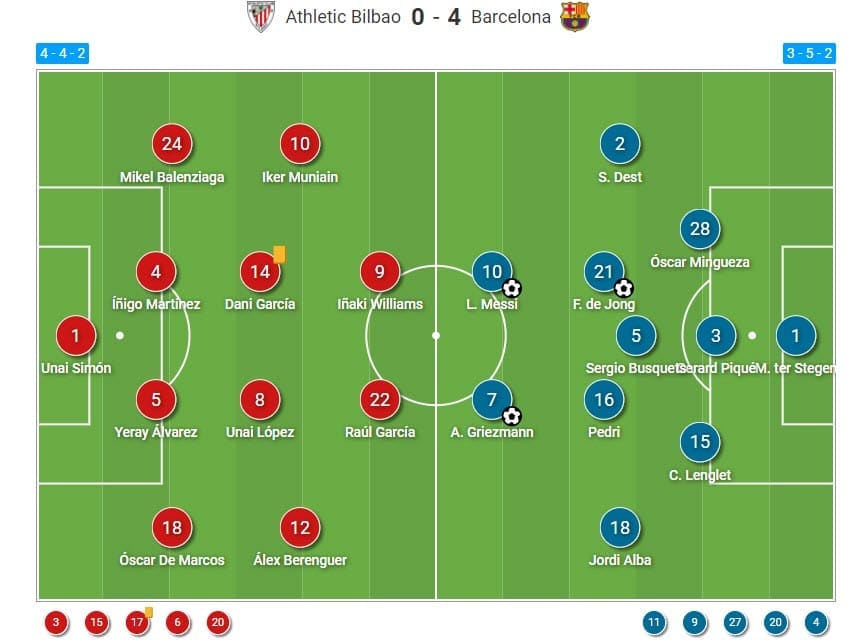
Barcelona, on the other hand, were in their 3-5-2 system as Koeman stayed faithful to his new structure. The only real surprise was the inclusion of Antoine Grizemann over Ousmane Dembélé and the return of Gerard Piqué, whose fitness was still a doubt, in the back three.
The rest of the squad was as expected with Lionel Messi leading the team to another big triumph. Frenkie de Jong was another focal point, this time from midfield, as the Dutchman completely dominated the game next to Pedri and Sergio Busquets. Jordi Alba and Sergiño Dest were the wingbacks on the night while Clément Lenglet and Óscar Mingueza completed the lineup.
Athletic Club’s lack of vertical compactness
Coming into this game, we knew what tactics both teams would likely deploy. Barcelona were always going to be on the offensive and with Koeman opting for the 3-5-2, the Catalans dominated the possession. Marcelino, on the other hand, also didn’t surprise us with his approach.
Athletic Club’s low defensive block in a 4-4-2 was always going to be used but on Saturday, their structure and pressing were highly flawed. The idea was to follow Real Madrid’s blueprint from their big LaLiga win over Barcelona before this clash but the Basques couldn’t replicate Zinedine Zidane’s formula for a number of reasons. One of the major ones was compactness or rather, lack thereof.
Even though Barcelona’s 3-5-2 system is much more effective against high-pressing teams, it did the job perfectly against Athletic Club. Why was that? Simple, the three in the back it offers were crucial in ensuring numerical superiority in the first phase of build-up against the 4-4-2 without the need to drop an extra midfielder in the backline. That enabled Barcelona to progress up the pitch directly through their centre-backs – either by running with the ball or just through vertical passing.
The progression sequence followed a simple pattern of ‘out-in’ to access midfielders like Busquets or De Jong between the lines. Athletic Club’s forward line of Williams and García would press the backline while the wide midfielders pushed up to make a 4-3-3 when the ball went wide. The full-backs were tasked with covering Barcelona’s wingbacks but the losing side was disjointed and easily manipulated by the victors.
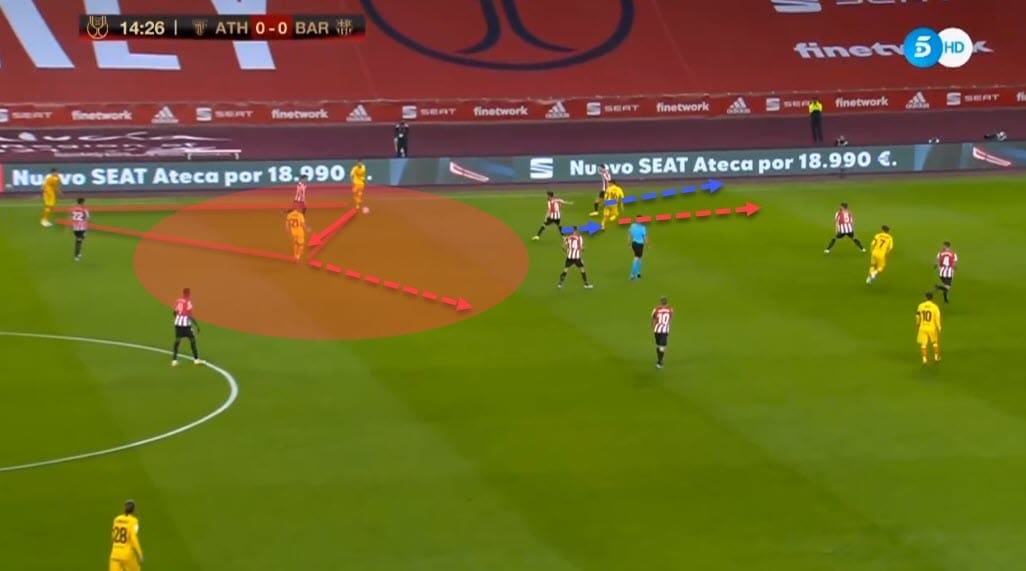
Notice in the image above a fairly standard sequence of play in Barcelona’s tactics. The first line of Athletic Club’s press is easily bypassed and the Catalans progress towards the flanks. There, Pedri or Antoine Griezmann would make a run beyond the defensive line, dragging the second line of defence along with them.
De Jong and Busquets would often stay deeper in those scenarios, receiving the ball in huge pockets of space that gave them enough time and freedom to dictate the game. Notice above how Lenglet has pushed up as a result of the 3v2 in the first line and can now create an overload on the wide defenders along with Alba and De Jong.
Barcelona used these tactics to not only progress up the pitch but also to make quick switches of sides and isolate their wingbacks. The following example can show us that more clearly.
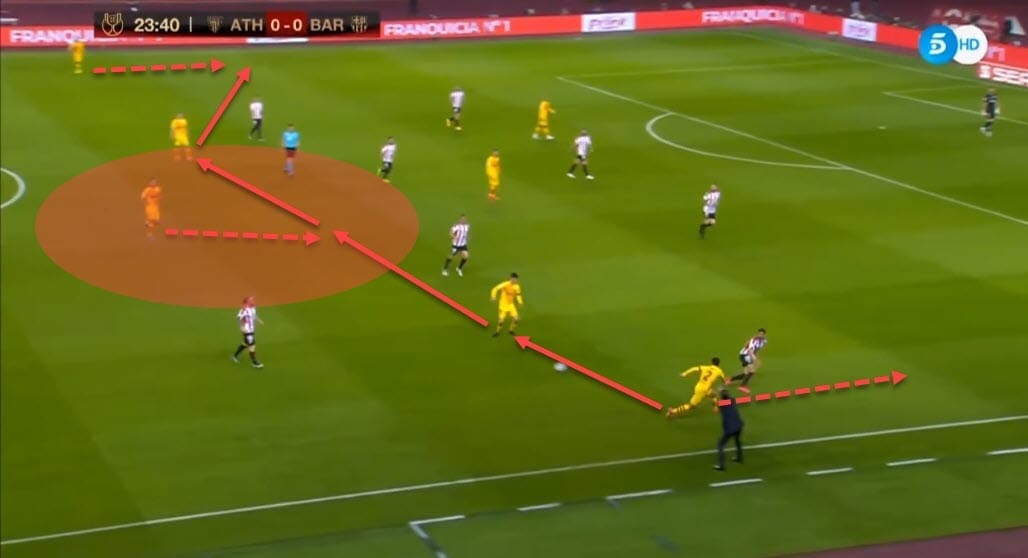
Once again it’s one of the midfielders who can receive in acres of space because Athletic Club are neither putting pressure nor ensuring their lines retain vertical compactness. Barcelona use this chance to string together a couple of quick passes to switch sides towards Alba who can run into the final third and the box.
Unai López was mostly in charge of covering Busquets but Pedri’s presence between the lines and him dropping deeper or drifting wider to combine with his teammates often attracted his attention, dragging him away and freeing Barcelona’s pivot.
Interestingly, Barcelona’s first goal on the night was also the result of Athletic Club’s lack of compactness and it opened the floodgates for the next three to arrive rather quickly. As soon as the Catalans managed to find Messi in that pocket of space, the Argentine put it to good use.
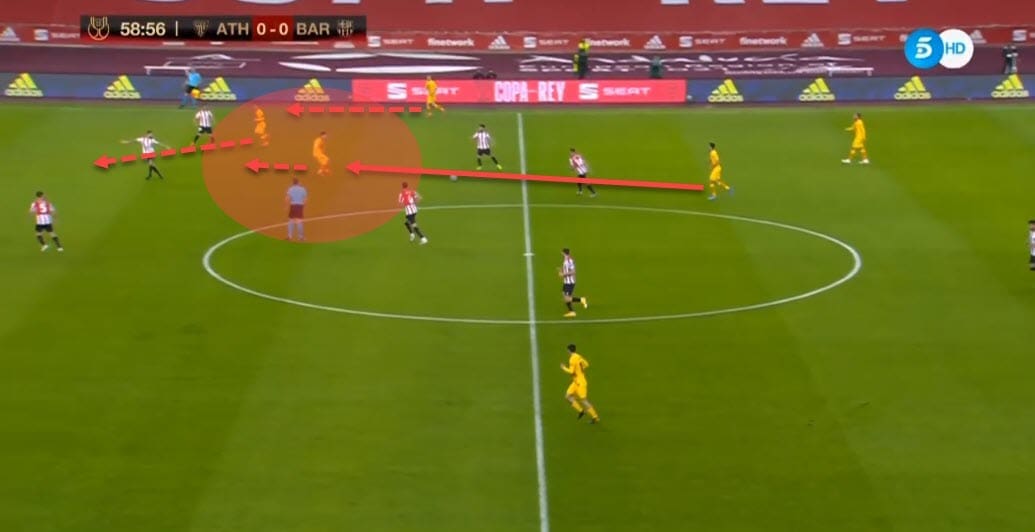
This time the second line is attracted by Busquets’ deeper positioning while Griezmann pins the backline and drags them in the opposite direction. This opens up the space for Messi to receive unmarked and gives him time to turn and run with the ball.
Once again, Barcelona’s manipulation ensured they had the tools to dismantle Athletic Club’s (mostly) inefficient low block.
Barcelona’s counter-pressing & (lack of) fouls
Soon after the first whistle, we realised Athletic Club’s only weapon in attack would be long balls into the forwards who they aimed to isolate against Barcelona’s relatively slow backline. The 3-5-2’s rest defence has been shaky throughout the overall season since there’s no adequate cover behind the very attacking-minded wingbacks in Dest and Alba.
Real Madrid utilised it perfectly but Athletic Club couldn’t because Barcelona’s pressing and counter-pressing was extremely effective on the night. Off the ball, Koeman deployed a mid-to-high press that aimed to shut down passing channels rather than aggressively aim to recover possession high up the pitch.
This meant that they would force mistakes and blind clearances rather than turnovers in the final third. Here’s an example of how their man-marking pressing structure looked like.
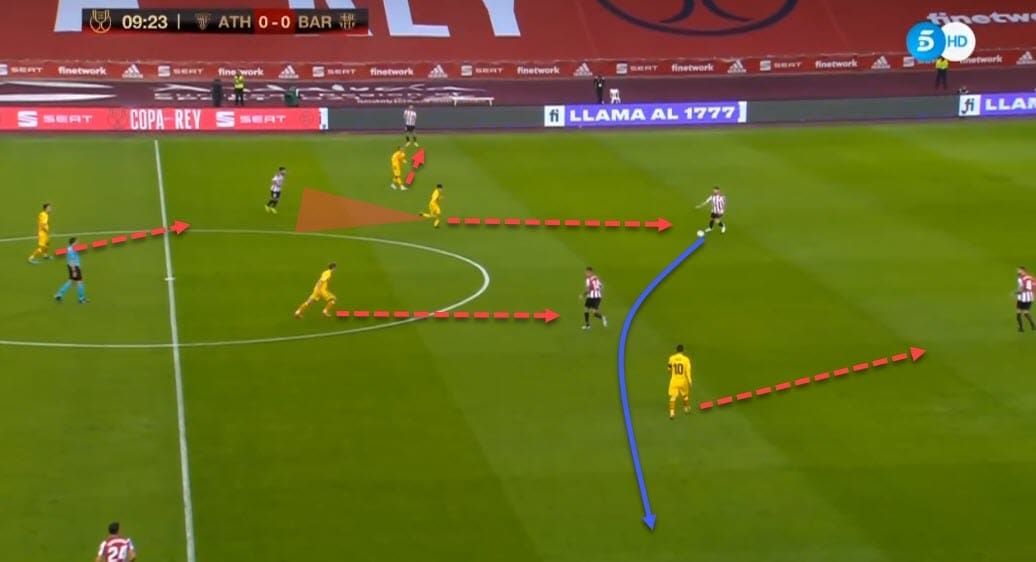
Usually, either Messi or one of the midfielders would press the ball-carrier while also keeping the pivots in the cover shadow, as you can see above. If the player moving out to press was on a pivot, he would be replaced by a deeper midfielder, usually De Jong or Busquets. Out wide, the wingbacks would stay high to put immediate pressure on the wide midfielders or the full-backs.
Barcelona had a man-marking scheme in place but would mostly not press to the opposition box. This did leave Athletic Club with some chances of progression but their passing was not good enough to make use of the potential superiorities on the pitch. Let’s take a look at another good example showing the same principles.
Again, mid-to-high block with one player for the ball-carrier and a deeper player taking over the marking of a pivot. Dest is extremely high, putting pressure on the full-back and Athletic Club are forced into an unsuccessful long ball.
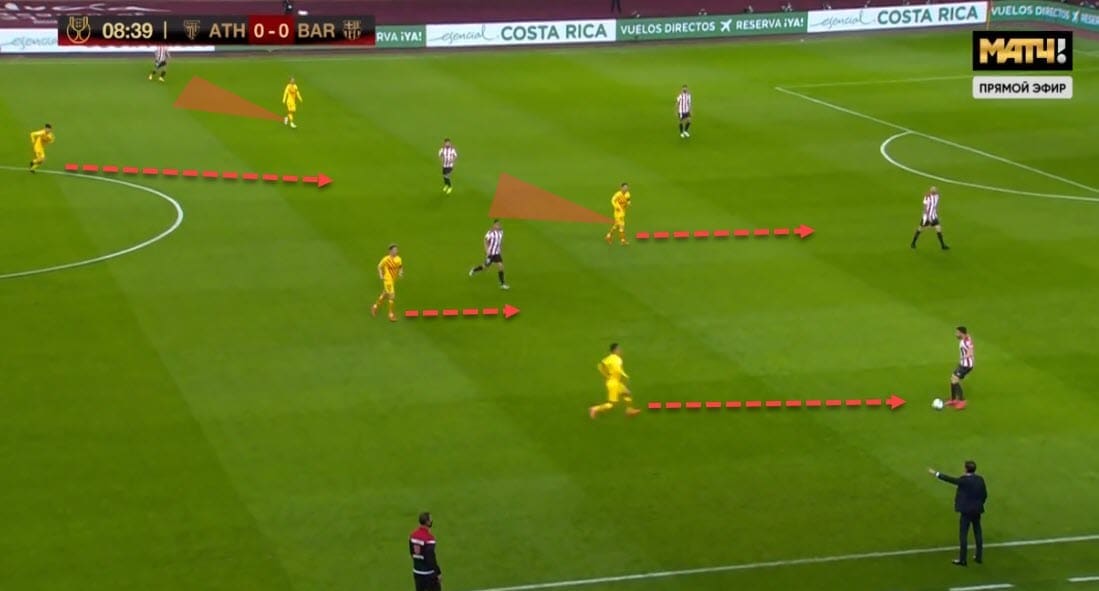
This sequence also segues perfectly into another way Barcelona nullified Athletic Club’s strengths. There were only two ways the Basques could’ve scored a goal on Saturday night: a long ball into Williams and him beating one of the Catalans’ defenders in a 1v1 duel or a set-piece play from a dangerous area.
However, as we’ve already established in this tactical analysis, Barcelona’s good press and counter-press ensured there was no clear opportunity for smooth transitions. Athletic Club would often clear the ball blindly towards their forwards but if we take a look at their aerial duels and overall duels on the night, we can see that their success rate in the opposition’s half of the pitch was extremely low.
Only 2/11 aerial duels in the opposition half were won on the night and even if they did receive there after a quick switch, it were Barcelona defenders who came out on top in the duels, as can be seen from the graph on the right.
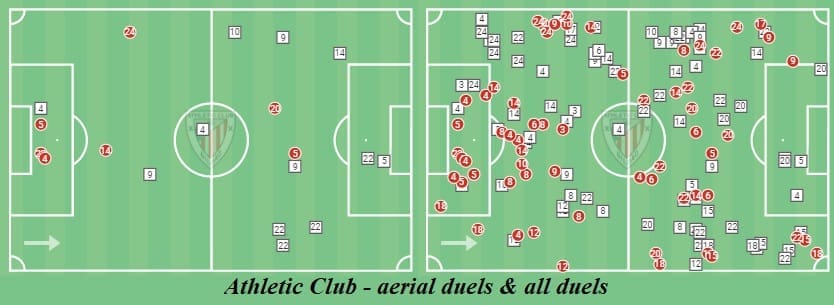
Athletic Club did pose some threat from set-pieces but Barcelona did well to avoid getting into such dangerous situations in the first place. They did that by good counter-pressing as well as not conceding fouls in key areas of the pitch.
Below is a graph depicting all of their fouls on the night and you can see that only 5/13 are in their half of the pitch. This minimised the threat as they could avoid direct crosses into the penalty area. Their counter-pressing was effective, as can be seen from the low number of fouls in the first place, but also because they knew when and how to efficiently stop a quick transition in its roots.
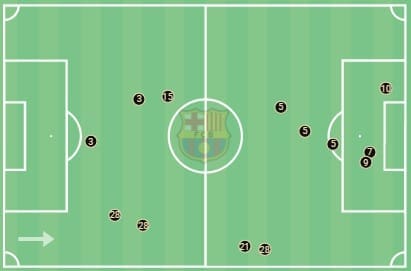
De Jong the total footballer
Even though Messi’s two goals on the night and the man of the match award rightfully puts the spotlight on him, it was also De Jong who completely dominated the opposition. The first three goals were made possible by the Dutchman and he was an instrumental part in everything good Barcelona did against Athletic Club – from the build-up phase, presence in the box and the defensive work, De Jong was everywhere.
Let’s review what makes him such a total footballer with an incredibly versatile arsenal. For the first goal, we can see him first drift out wide to make an overlapping run on the right side of the pitch. Messi finds him with a pass and De Jong continues the attack with a beautiful low cross into the box.
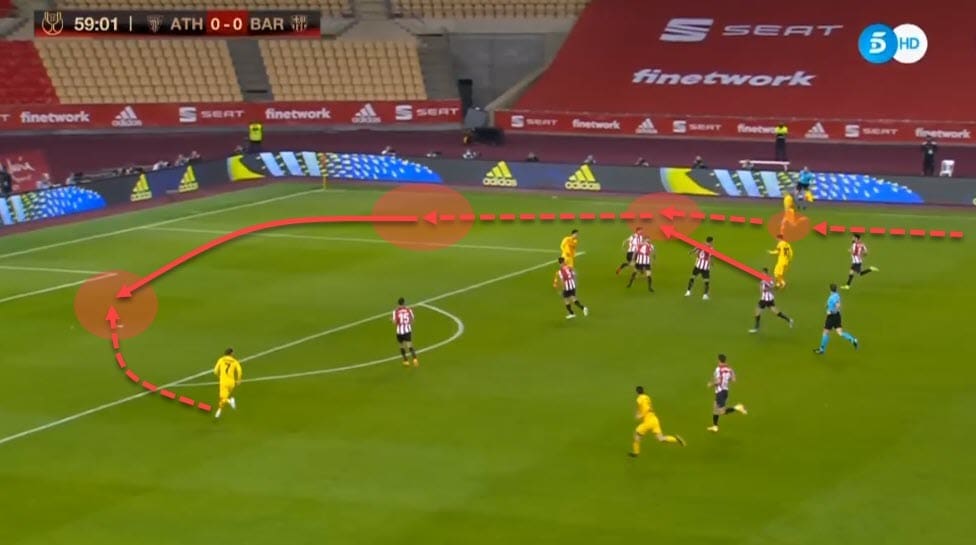
Griezmann also does well to move into the right position but also to finish the chance with a clean strike past Simón. That sequence demonstrated De Jong’s crossing, understanding of movement and also great timing to wrap it all up.
For the second goal, it’s the Dutchman who puts the finishing touches on another stellar sequence of play. When he’s deployed in the midfield role, De Jong has the freedom to make bursting runs beyond the opposition’s line and directly into the box.
At times, we can see his poacher-like instincts kick in and this was one such moment when he created a pocket of space for himself to rattle the inside of the opposition’s net with a great header.
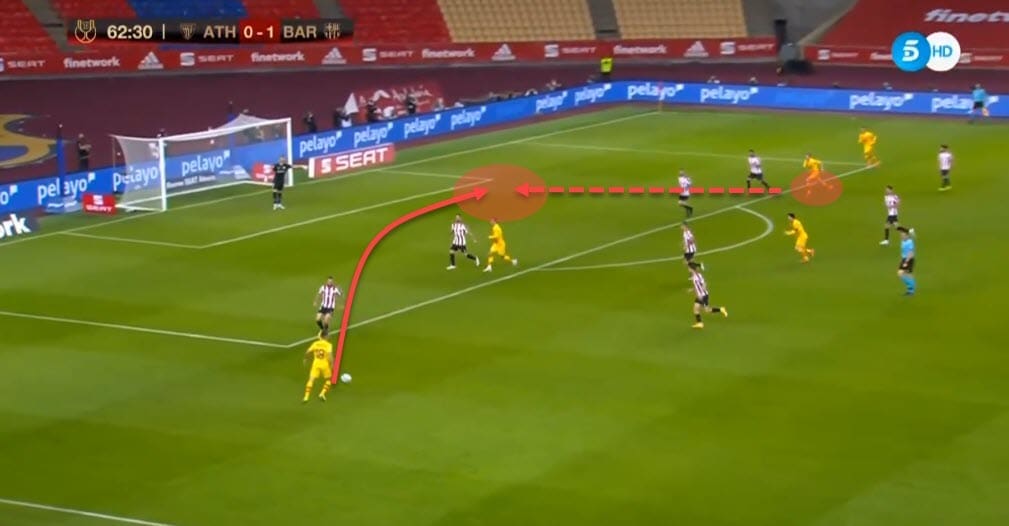
Alba also did very well to deploy a pinpoint cross into the penalty area. Finally, the third goal, this time scored by Messi, was a work of art between two magicians of the game. In this sequence, both players moved flawlessly and showcased their excellent control in tight spaces but also the understanding of controlling the tempo.
They know exactly when the play has to be sped up or slowed down and the fact that only two players were able to cruise through so many defensive players says it all. Of course, a big part of that is also Messi’s undeniable quality but De Jong did extremely well to make it all happen for the Argentine.
The result is the most beautiful of all four Barcelona goals scored on the night.
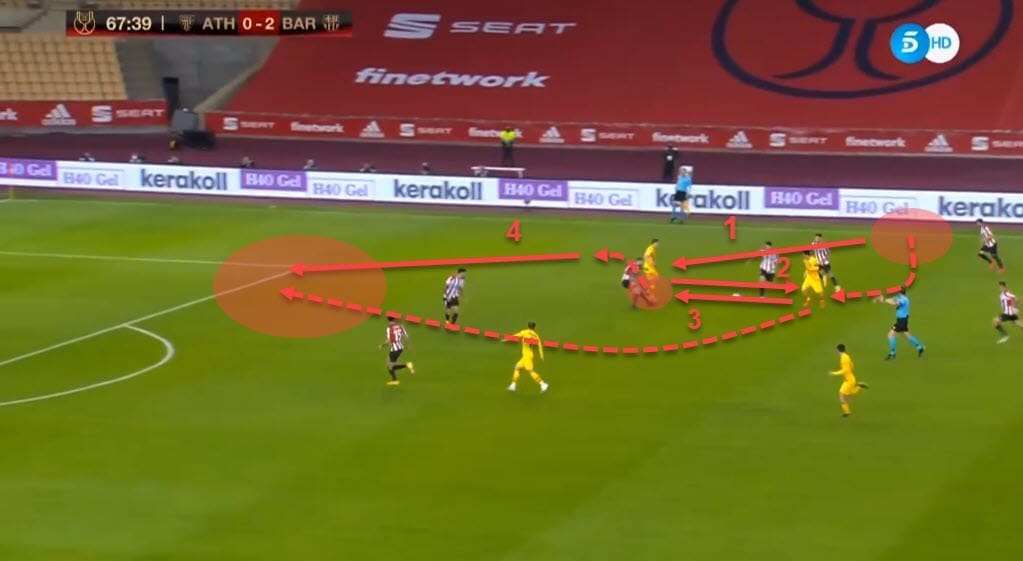
Final remarks
It’s difficult not to feel for Athletic Club and Marcelino’s tactics do make some sense on paper. After all, Barcelona traditionally struggle against low blocks but on Saturday, there was only one team competing for that title.
Hopefully, this tactical analysis managed to show you what were some of the key points that made the Catalans’ triumph possible in the first place.






Comments